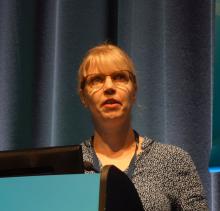COPENHAGEN – Bright light therapy is a well-established, guideline-recommended treatment for seasonal affective disorder, and many people prone to depression keep a light box at home. But are you ready to embrace the dark side – that is, dark therapy for bipolar mania, or its vastly more patient-friendly offshoot, virtual dark therapy?
And it’s a lot easier on patients than the massive sensory deprivation imposed by the original form of dark therapy, which entails keeping a patient with mania in a completely dark room for 14 hours per night, Tone E.G. Henriksen, MD, observed at the annual congress of the European College of Neuropsychopharmacology.
She was lead author of a pioneering randomized controlled trial demonstrating that bipolar patients who wore blue-blocking, orange-tinted glasses for 14 hours per evening while hospitalized for a manic episode experienced a significant improvement in scores on the Young Mania Rating Scale (YMRS), compared with patients randomized to wearing clear lenses. Moreover, the between-group difference achieved strong significance in just 3 days.
That’s a remarkable result, because bipolar mania is such a challenge to treat pharmacologically. The standard medications – mood stabilizers and antipsychotic agents – are slow in onset of effect, observed Dr. Henriksen, a psychiatrist at the University of Bergen (Norway).
Backing up, she noted there is strong evidence of seasonality to bipolar disorder, as highlighted in a systematic review of 51 publications (J Affect Disord. 2014 Oct;168:210-23). This recognition has prompted numerous researchers to focus attention on the abnormal circadian rhythms prevalent in patients with bipolar disorder, for which the light/dark cycle is a powerful synchronizing signal to the hypothalamic suprachiasmatic nucleus, the master clock of circadian rhythms. This understanding led to a landmark case control pilot study by Italian investigators who exposed 16 bipolar inpatients experiencing a manic episode to 14 hours of complete darkness from 6 p.m. to 8 a.m. for 3 consecutive nights. The outcome was a dramatic reduction in YMRS scores in the dark therapy group, compared with 16 matched control inpatients, with all participants on pharmacologic treatment as usual (Bipolar Disord. 2005 Feb;7[1]:98-101).
“This was really something,” Dr. Henriksen recalled.
She and her colleagues were impressed by other investigators’ discovery of specialized retinal ganglion cells, known as intrinsically photosensitive retinal ganglion cells, which are responsible for conveying the daylight signal to the brain. These specialized cells contain melanopsin, which is blue light sensitive. The Norwegian investigators reasoned that it might not be necessary to expose patients with mania to prolonged utter darkness to achieve rapid symptomatic improvement, as the Italian psychiatrists did. Instead, they hypothesized, it might be sufficient just to block the blue light, low-wavelength end of the spectrum. And that turned out to be the case.
Their randomized, single-blind, multicenter study included 23 patients with bipolar disorder who were hospitalized for manic symptoms. All remained on their standard background psychiatric medications while being randomized to wear orange-tinted, blue light–blocking glasses, which allowed passage of almost all light above 530 nm, or clear glasses. Participants were instructed to wear their glasses from 6 p.m. to 8 a.m. for 7 consecutive nights. They took their glasses off when they switched off the lights at bedtime, but they had to put them back on if they turned on a light before 8 a.m. The patients also wore an activity monitor.
The results were dramatic: The blue-blocking glasses group had a mean 14.1-point drop in their YMRS score from a baseline of about 25, compared with a mere 1.7-point decline in the control group. Moreover, Dr. Henriksen said, this result might actually underrepresent the true clinical effect of blocking blue light to the brain, since two patients in the blue-blocking glasses group experienced such rapid symptomatic improvement that they were moved from an acute psychiatric ward to a local hospital midstudy, a sudden change that triggered transient worsening of manic symptoms in both patients.
The investigators documented improved sleep efficiency in the blue-blocking group. Another noteworthy finding was that, in the blue-blocking group, the elements of the YMRS related to increased activation declined before the measures of distorted thoughts and perceptions. So did motor activity as recorded by actigraph. Meanwhile, nighttime activity worsened in the control group; they received substantially more sedatives, hypnotics, anxiolytic agents, and antipsychotic medications (Bipolar Disord. 2016 May;18[3]:221-32).
The mechanism underlying the improvement in sleep regularity and manic symptoms achieved by blocking blue light is not understood. Dr. Henriksen finds “very compelling” a theory put forth by prominent chronobiologist Daniel Kripke, MD, of the University of California, San Diego. He has shown in animal studies that a change in light exposure can trigger bifurcation in the circadian rhythms of the suprachiasmatic nucleus. The resultant suppression of melatonin secretion results in excess production of hypothalamic triiodothyronine, which in turn affects production of other key hormones. In patients with bipolar disorder, this could trigger mania, according to Dr. Kripke (F1000Res. 2015 May 6;4:107.
Dr. Henriksen reported having no financial conflicts regarding her study, which was conducted free of commercial support. She serves as a consultant to Chrono Chrome AS.


